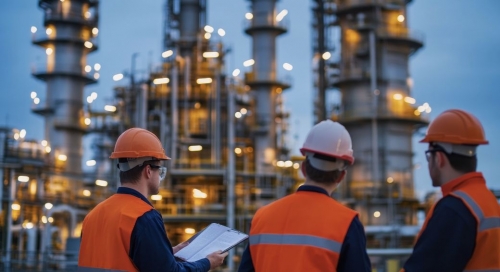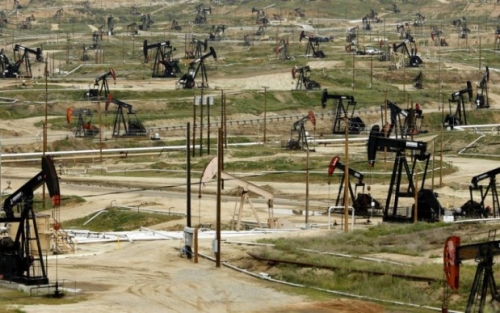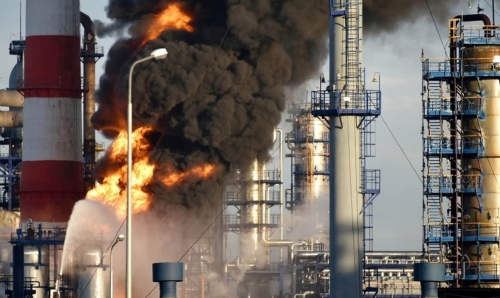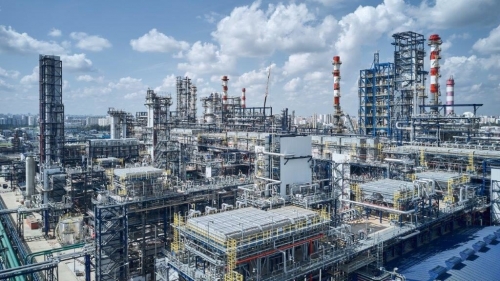Despite a rally in earlier in the week, oil prices ended lower week-on-week due to ongoing concerns over US President Trump's tariff policy and an increase in US crude stocks.
BKR Rig Count | The total active drilling rigs in the United States increased by 6 last week, to 582. Oil rigs increased by 7 to 479, and gas rigs dropped by 1 to 98. Rig count in the Permian Basin increased by 5 to 303 | Jan 31 | BKR NAM Rig Count
US Crude Inventories, excluding those in the Strategic Petroleum Reserve (SPR), increased by 3.5 MMbbl to 415.1 MMbbl (about 6% below the 5y average for this time of year). On the products side, gasoline increased by 3.0 MMbbl (slightly below the 5y average). Distillate fuels decreased by 5.0 MMbbl (9% below the 5y average). Total commercial petroleum inventories decreased by 13.9 MMbbl | Jan 24 | EIA Weekly Report
President Trump has imposed tariffs of 25% on Canada and Mexico, the top two suppliers of foreign crude to the US, and 10% levy on China, in a move marking a new phase of the trade war. Energy imports from Canada, which ships almost all of its roughly 4 mb/d of crude exports to its southern neighbor, face a reduced levy of 10%. Canada and Mexico have announced plans for retaliatory tariffs on the US, with Canada imposing 25% counter-tariffs on $155 bn worth of American-made products. China has vowed “corresponding countermeasures” without immediately announcing any new tariffs and has pledged to file legal proceedings with the WTO. Bloomberg estimates the move will raise the average US tariff rate to 10.7% from near 3% currently and “deal a significant supply shock” to the domestic economy, where US GDP would suffer a 1.2% hit and core inflation would increase by 0.7%. The EU is not aware of any additional tariffs being imposed on EU products, but has threatened to "respond firmly" if the US imposes tariffs on the bloc | Feb 2 | Bloomberg
US central bank will hold interest rates steady for the foreseeable future due to uncertainty over President Trump's policies and their impact on the economy, says Fed Reserve Chair Jerome Powell. The strong performance of the US economy and stability of the labor market also give the Fed room to hold off on further rate cuts. The Fed wants to see further declines in inflation and "serial readings" suggesting progress before cutting rates, and policymakers are not in a rush to lower borrowing costs, with the next rate adjustment potentially delayed until June or later | Jan 29 | Bloomberg
OPEC+ is unlikely to alter existing plans to raise output gradually when it meets on Monday, OPEC delegates told Reuters, despite President Trump urging OPEC and its de facto leader Saudi Arabia to bring down prices | Jan 31 | Reuters
Nigeria’s imports of gasoline are on course for an eight-year low as the country’s new mega-refinery pushes out foreign suppliers, boosting the African nation’s fuel independence. Shipments into the country stood at about 110,000 bpd during Jan. 1-24, most of which come from Europe. Majority of the slowdown in gasoline imports “is due to the ramp up of the Dangote refinery,” according to a Vortexa analyst and “Northwest Europe will have to find alternative homes for its gasoline supplies” | Jan 29 | Bloomberg
US GDP grew at a 2.3% annualized rate in the fourth quarter, driven by strong consumer spending that offset drags from a Boeing strike and leaner inventory investment. Consumer spending advanced at a 4.2% pace, the fastest since late 2021, led by a pickup in motor vehicle sales, and a measure of underlying inflation rose 2.5%. Bloomberg survey shows 2025 GDP growth will cool to 2.2% on average, with economists anticipating only a few Fed interest-rate cuts | Jan 30 | Bloomberg
The Bank of Canada cut interest rates by a quarter percentage point to 3% and dropped guidance on future rate moves due to US President Trump's tariff threat. The bank sees inflation holding close to the 2% target well into 2026 and the economy strengthening gradually. The bank's decision not to provide guidance on future rate moves suggests it is waiting for clarity on Trump's trade policy before making further adjustments to monetary policy | Jan 29 | Bloomberg
Iraq's parliament passes a plan to boost payments to oil companies in the Kurdistan region. The plan would pay $16 a barrel for oil production and transportation, still below the $26 a barrel that oil firms get from their current contracts. The move aims to resume oil exports from the region, which have been halted for almost two years due to cost disputes | Feb 2 | Bloomberg
Production was reduced by 200k bpd at the Rumaila North & South field, Iraq, due to a fire that broke out at a gas isolation station at Rumaila North, with operations at 60 producing oil wells halted. The field’s gas supply is understood to have also been affected | Jan 30 | S&P
Looking ahead
ENVERUS FUNDAMENTAL EDGE–A TOUCH BEARISH – Jan 2025 | Brent prices broke free of the low-$70s trading range in 4Q24 and recently rose to Enverus’ 2025 annual average target of $80/bbl. This repricing was driven by sanctions applied on Russian oil tankers that ship ~900 Mbbl/d. Roughly half of those volumes are expected to skirt sanctions, according to consensus estimates. Enverus Intelligence Research (EIR) views the sustained uptick as oil markets properly pricing fundamentals and, in particular, low stock levels. OPEC will be unable to fully unwind production cuts if it wishes to keep Brent prices in the mid-$80s. Non-OPEC supply growth driven by Canada, Brazil, Guyana-Suriname and the U.S., coupled with annual demand growth of ~1.0 MMbbl/d, lead to an oversupplied market. Once again OPEC has a dilemma: do group members defend market share or pursue price stability? EIR assumes they protect price stability, in keeping with recent behavior. The cratering of apparent demand measures has ignited speculation that peak Chinese demand has come early. Conversely, IEA demand indications aren’t as dire. Future growth hinges on whether the observed weakness reflects cyclical economics or structural fuel substitution. EIR does not doubt that electric vehicles and LNG trucks have displaced oil consumption. That said, per-capita oil consumption (excluding the transport sector) remains low relative to more developed economies. After a pause this year in Chinese demand growth because of an uncertain global trade environment, EIR expects the country’s oil consumption will grow ~300 Mbbl/d in 2026, with growth decelerating and demand peaking by 2030. Three key natural gas pipelines in 4Q24 reached FID from the Permian toward the Gulf Coast: Blackcomb, Gulf Coast Expression Expansion and Hugh Brinson, confirming EIR’s expectations that Permian infrastructure is not an issue. These pipelines will add 5.3 Bcf/d of egress capacity by 2027, supporting EIR’s Permian natural gas production forecast through 2030. Another 6.8 Bcf/d of proposed Permian pipe has potential to drive additional growth out of the basin. Since 2021, power demand net of weather grew ~1.3 Bcfe/d annually, but the pace slowed somewhat in 4Q24. As for interfuel competition, wind generation underperformed relative to its capacity additions, while coal and gas outperformed over the same period. Furthermore, EIR observed gas weaken relative to coal as higher gas prices likely weighed on gas-fired generation economics. Risks to gas consumption are skewed to the downside in 2025, due to likely stronger wind generation (mean reversion) and higher gas prices. European natural gas storage is 65% full. The strong winter gas storage withdrawal rate has propped up Dutch TTF natural gas prices. With the end of Russian gas flows through Ukraine and a Norwegian LNG facility outage, EIR expects international gas prices to remain elevated as buyers rely on globally sourced LNG to meet their gas requirements | Jan 27 | Enverus
Bloomberg - Energy Transition Investment Trends 2025 | Global energy transition investment has surpassed $2 trillion for the first time and more than doubled since 2020, but growth slowed to just 10.7% in 2024, from 24-29% in each of the years 2021-23. By far the largest sectors are electrified transport at $757 billion, renewable energy at $728 billion and power grids at $390 billion. All three of these sectors grew to new records in 2024, as did energy storage, which shrugged off headwinds to reach $54 billion. In contrast, the other six sectors (nuclear, carbon capture and storage, hydrogen, clean shipping, electrified heat and clean industry), together accounted for just 7.4% of total investment, and actually declined 23% in 2024, illustrating the ongoing challenges in scaling up ‘emerging’ clean technologies. The Asia Pacific region grew fastest, at 21% year-on-year, and surpassed $1 trillion in 2024, accounting for half of the world’s energy transition investment. Mainland China’s growth alone accounted for two-thirds of the global uptick, as the market invested $818 billion in 2024 – more than double any other economy. US investment was stable at $338 billion, while EU and UK investment fell. Of the top 10 markets, mainland China invested most as a portion of GDP (4.5%), followed by Germany, the EU-27 bloc and the UK. Annual investment is running at just 37% of the levels required for the rest of this decade if the world is to get on track for net zero by 2050 | Jan 30 | Bloomberg

%20(1).png)



